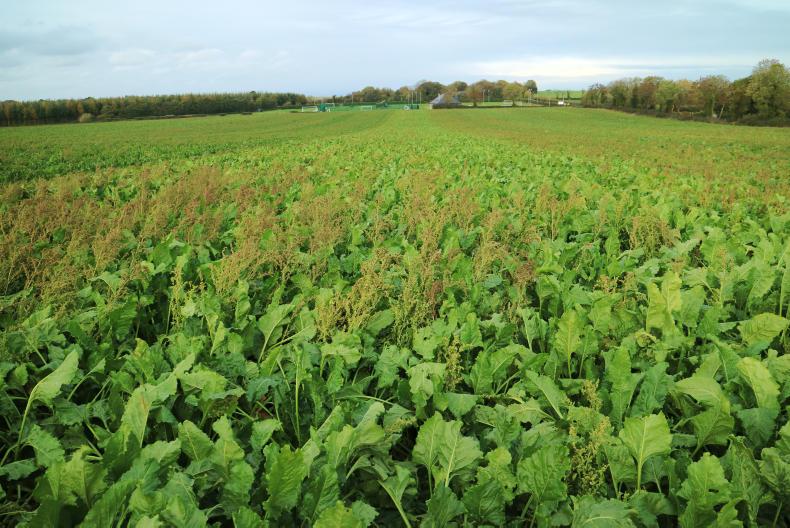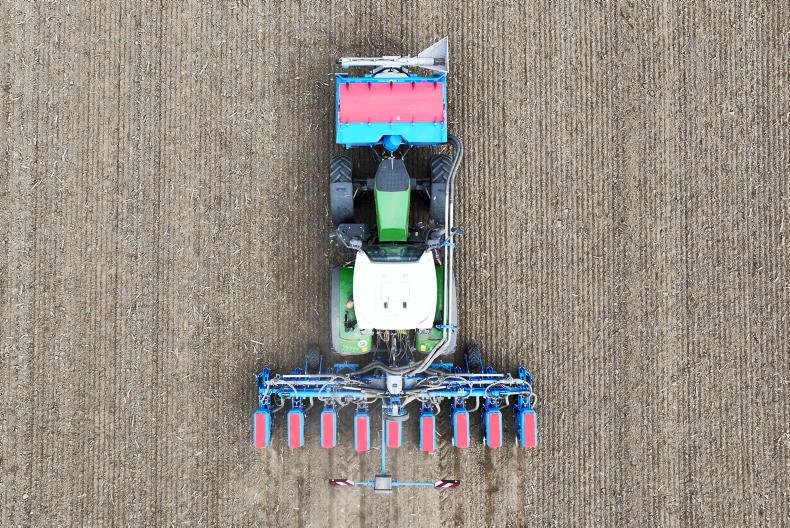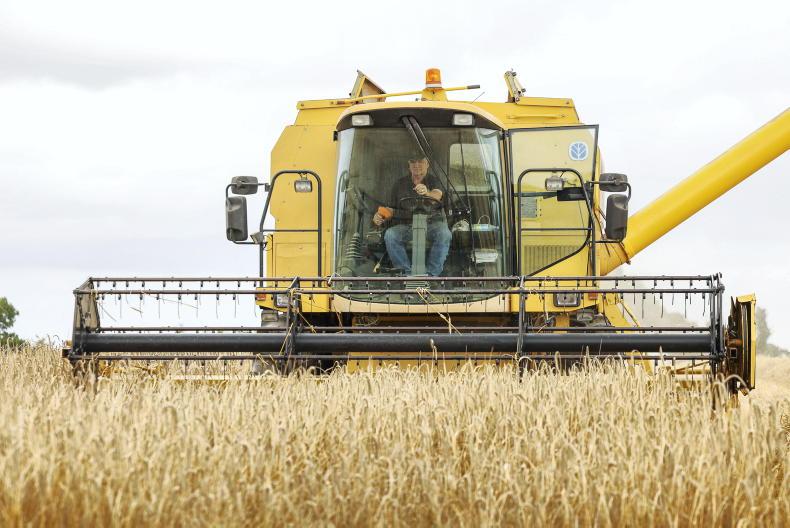There has been a small amount of beet harvesting taking place this week but the bulk of the harvest has yet to begin. Like every crop grown in Ireland this year, beet has had to contend with the late spring and dry, hot summer.
Unlike many crops, however, beet has the capacity to really capitalise on the good growing weather this autumn and crops continue to bulk on a daily basis.
Speaking with agronomists around the country and visiting many crops throughout the year, the big challenges facing beet crops this season were the dry soil conditions which affected nutrient availability, crop development and weed control. Low disease pressure and a good growing backend, however, were some of the benefits of 2018.
Beet crop in numbers
The area of fodder and sugar beet grown in the country increased by 17% since 2017, according to the Department of Agriculture. While this is lower than the 50% increase seen in maize area, it is still significant. Fodder beet area increased by 1,448ha while sugar beet area increase 142ha, bringing the total area of beet to just under 11,000ha (see table 1).
Cork is growing the highest area of both fodder and sugar beet, over 1,200 ha more than the next highest county, Wexford at 1,681ha. This was followed by Laois, at 1,031ha and Carlow at 954ha. See the graph for the top 10 beet growing counties this year. Reports suggest that most of the additional area came from existing growers increasing their area.
Establishment issues
This season’s crops can be categorised into those which were sown on time into a well-prepared seedbed with adequate moisture levels and those which were sown late when the dry weather began to grip. Establishment among those later-sown crops was uneven, down as low as 20% in some cases. It took the first real showers of rain before the rest of the seed germinated. This led to uneven crop development which will prove to be a challenge during harvest.
Weed control
Weed control was the biggest challenge this year and many growers will say they’ve never contended with a year like it. Dry conditions at the time of spraying meant that residual herbicides were not as effective and weeds had a chance to get away. In some cases, growers delayed weed control to allow all of their beet seeds to emerge, which later proved to be a mistake. When moisture did arrive, this led to a late flush of weeds. Subsequent herbicide applications proved too late for those growers. Growers pulling beet with a belt harvester are likely to experience difficulty when harvesting crops with heavy infestations of weeds. Fields can be seen with bad infestations of either redshank, charlock or fat hen , plus many other weeds.
Drought pressure
Crops which germinated and established in good conditions were able to withstand the worst effects of the drought. Those which were sown later on very dry ground, however, were exposed to the full effects of the drought and appeared to be knocked back slightly.
While the roots were able to access some moisture deep in the soil profile, the bulk of the nutrients required for growth were inaccessible as they were incorporated in the top few inches of soil, which were the driest. This led to signs of both micro and macro nutrient deficiencies in the worst-affected crops.
This was particularly evident in the driest parts of Wexford, Kilkenny, Carlow, Tipperary and the northeast. These symptoms were eased with the arrival of rain.
Disease pressure remained low throughout the season although there have been reports of rust and ramularia creeping into crops.
Silver Y moth bites
Growers reported an explosion of silver Y moth (Autographa gamma) infestations in July/early August. While problems appear to have been localised, reported incidents of some form of damage were recorded in most beet growing areas.
In some cases the leaf damage was minor, but in other cases over 70% of the leaf area of infested leaves was lost. Growers found control using insecticides difficult once infestation had taken place.
Harvest expectations
While many growers will remember this as one of the most challenging years for growing beet in recent memory, good growing conditions over the past number of months have helped the crops recover.
The expectation is that most crops will still preform reasonably well. Fodder beet crops, which were lifted in the past week, yielded 25-26t/ac but many growers feel 30t/ac plus is achievable.
Markets
While recent good growing weather has eased some of the pressure for fodder, many livestock and dairy producers secured beet in advance of harvest this year. Prices quoted to the Irish Farmers Journal range from €50/t to €55/t for delivered beet.
Read more
Grain prices: Ukraine planting almost complete and Russian maize yields back
US judge upholds glyphosate cancer verdict, cuts damages
There has been a small amount of beet harvesting taking place this week but the bulk of the harvest has yet to begin. Like every crop grown in Ireland this year, beet has had to contend with the late spring and dry, hot summer.
Unlike many crops, however, beet has the capacity to really capitalise on the good growing weather this autumn and crops continue to bulk on a daily basis.
Speaking with agronomists around the country and visiting many crops throughout the year, the big challenges facing beet crops this season were the dry soil conditions which affected nutrient availability, crop development and weed control. Low disease pressure and a good growing backend, however, were some of the benefits of 2018.
Beet crop in numbers
The area of fodder and sugar beet grown in the country increased by 17% since 2017, according to the Department of Agriculture. While this is lower than the 50% increase seen in maize area, it is still significant. Fodder beet area increased by 1,448ha while sugar beet area increase 142ha, bringing the total area of beet to just under 11,000ha (see table 1).
Cork is growing the highest area of both fodder and sugar beet, over 1,200 ha more than the next highest county, Wexford at 1,681ha. This was followed by Laois, at 1,031ha and Carlow at 954ha. See the graph for the top 10 beet growing counties this year. Reports suggest that most of the additional area came from existing growers increasing their area.
Establishment issues
This season’s crops can be categorised into those which were sown on time into a well-prepared seedbed with adequate moisture levels and those which were sown late when the dry weather began to grip. Establishment among those later-sown crops was uneven, down as low as 20% in some cases. It took the first real showers of rain before the rest of the seed germinated. This led to uneven crop development which will prove to be a challenge during harvest.
Weed control
Weed control was the biggest challenge this year and many growers will say they’ve never contended with a year like it. Dry conditions at the time of spraying meant that residual herbicides were not as effective and weeds had a chance to get away. In some cases, growers delayed weed control to allow all of their beet seeds to emerge, which later proved to be a mistake. When moisture did arrive, this led to a late flush of weeds. Subsequent herbicide applications proved too late for those growers. Growers pulling beet with a belt harvester are likely to experience difficulty when harvesting crops with heavy infestations of weeds. Fields can be seen with bad infestations of either redshank, charlock or fat hen , plus many other weeds.
Drought pressure
Crops which germinated and established in good conditions were able to withstand the worst effects of the drought. Those which were sown later on very dry ground, however, were exposed to the full effects of the drought and appeared to be knocked back slightly.
While the roots were able to access some moisture deep in the soil profile, the bulk of the nutrients required for growth were inaccessible as they were incorporated in the top few inches of soil, which were the driest. This led to signs of both micro and macro nutrient deficiencies in the worst-affected crops.
This was particularly evident in the driest parts of Wexford, Kilkenny, Carlow, Tipperary and the northeast. These symptoms were eased with the arrival of rain.
Disease pressure remained low throughout the season although there have been reports of rust and ramularia creeping into crops.
Silver Y moth bites
Growers reported an explosion of silver Y moth (Autographa gamma) infestations in July/early August. While problems appear to have been localised, reported incidents of some form of damage were recorded in most beet growing areas.
In some cases the leaf damage was minor, but in other cases over 70% of the leaf area of infested leaves was lost. Growers found control using insecticides difficult once infestation had taken place.
Harvest expectations
While many growers will remember this as one of the most challenging years for growing beet in recent memory, good growing conditions over the past number of months have helped the crops recover.
The expectation is that most crops will still preform reasonably well. Fodder beet crops, which were lifted in the past week, yielded 25-26t/ac but many growers feel 30t/ac plus is achievable.
Markets
While recent good growing weather has eased some of the pressure for fodder, many livestock and dairy producers secured beet in advance of harvest this year. Prices quoted to the Irish Farmers Journal range from €50/t to €55/t for delivered beet.
Read more
Grain prices: Ukraine planting almost complete and Russian maize yields back
US judge upholds glyphosate cancer verdict, cuts damages










SHARING OPTIONS